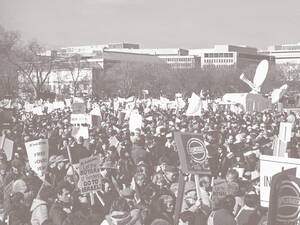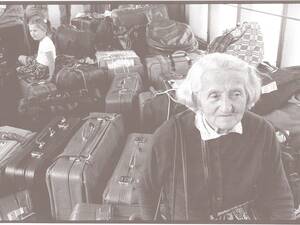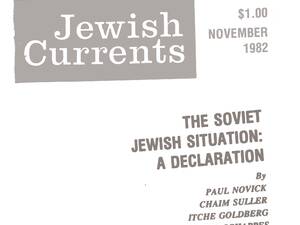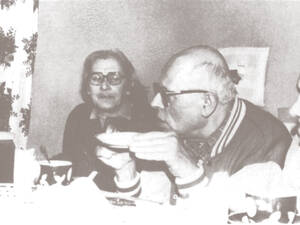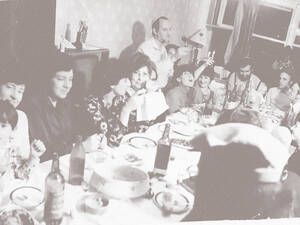How Jewish Currents Covered the Soviet Jewry Movement
Even once the magazine accepted the evidence of Soviet antisemitism, it continued to distrust the politics of the mainstream campaign.

When four leading intellectuals of the progressive, secular Jewish movement published “The Soviet Jewish Situation: A Declaration” in the November 1982 issue of Jewish Currents, they spoke as outraged and deeply disillusioned leftists. Morris U. Schappes, the editor of Jewish Currents, Paul Novick and Chaim Suller of the Morning Freiheit, and Itche Goldberg of Yidisher Kultur had all been committed Communists in the 1930s and ’40s and, in some cases, through the ’50s. Now they denounced the Soviet system’s violent suppression of Jewish culture as a “historic act of destroying a people by tearing up its culture by the roots” and a “rape” of “the most elementary principles of humanism and socialism.”
Those phrases announced the end of their fast-held belief that the USSR was fundamentally committed to overturning the traditional antisemitism of Eastern Europe and cultivating Jewish culture—a faith that had been strengthened by the Bolshevik government’s campaigns against antisemitism in the 1920s, and the flowering, until the mid-’30s, of Soviet Yiddish schools, publishing houses, and cultural institutions. Even Joseph Stalin’s savage murder of at least 13 Jewish cultural leaders on August 12th, 1952, had not fully shattered the editors’ confidence. It was only four years later, after Nikita Khrushchev’s speech before the Soviet Communist Party Congress detailing some of Stalinism’s crimes, that Jewish Currents undertook a “review and reappraisal” of its prior coverage. (“Why did this magazine in the past eight years fail to raise questions concerning the shutting down of Jewish cultural institutions in the Soviet Union?” asked the lead editorial. “Why did we not suspect foul play in the disappearance of leading Soviet Yiddish writers?”) But the heartfelt mea culpa fell short of asking fundamental political questions about the nature of the Soviet “dictatorship of the proletariat” and the ongoing status of national minorities in the USSR. Nor did the magazine’s soul-searching take account of the Soviet suppression of religious Jews and Zionists even in pre-Stalinist days.
It wasn’t until the early 1970s that the editors began to write forcefully and consistently against the oppression of Soviet Jews. In the 1971 editorial “Soviet Jews and the Right to Emigrate,” reprinted here, Jewish Currents decried the Soviet ban on emigration as a violation of the International Declaration of Human Rights, which the USSR had endorsed 23 years before; in “The Soviet Jewish Situation Again,” from 1975, the magazine denounced the “blatant antisemitism” of an article published in the Soviet government journal Ogonyok. Both pieces, however, still clung to the hope that the USSR would realize its socialist ideals and ultimately restore human rights to Jews. As the 1975 editorial wistfully suggested: “The fact that even a small number of Soviet Jewish emigrants . . . have returned or want to return to the cradle-to-grave social security of the USSR is further evidence” that the country remained home to “a socialist base.”
But by the time of the 1982 declaration, the four editors finally comprehended that the Soviet Union was pursuing what they called a “forced assimilation” of Jews, threatening “catastrophic” danger to “the survival of the Jewish people on Soviet soil.” They nevertheless carefully differentiated their views from those of the National Conference on Soviet Jewry (NCSJ)—the umbrella organization behind the mainstream “Let My People Go” campaign—with an analysis that reflected both a distrust of mainstream Jewish politics and a non-Zionist, diasporist sensibility.
The distrust between Jewish progressives and mainstream Jewish groups dated back to the McCarthy period, when organizations such as the Anti-Defamation League and American Jewish Congress conducted their own purges of leftists. The “Let My People Go” campaign had continued this tradition of allying with US governmental powers, holding leftwing protest movements at arm’s length and working closely with the US State Department and Cold War hawks such as Senator Henry “Scoop” Jackson. Progressive alienation was intensified by the mainstream’s proximity to Rabbi Meir Kahane, the founder of the fascistic Jewish Defense League (JDL), who promoted anti-Soviet violence to protest the ban on Jewish emigration. Although most Jewish organizations periodically denounced Kahane, the mainstream movement sometimes echoed the JDL’s rhetoric, especially its “Never Again” sloganeering. The 1990 editorial reprinted here, “Distorting Data on Soviet Anti-Semitism,” which criticizes the American Jewish Committee for misrepresenting the results of a survey about Soviet antisemitism, exemplifies Jewish Currents’ efforts in this era to hold mainstream Jewish organizations accountable for bending the narrative in service of Cold War aims.
Jewish Currents also differed from mainstream critics of the USSR in its unwillingness to endorse an exodus of Soviet Jews to Israel, which purported to represent Jews worldwide while maintaining an occupation of Palestinian lands that many Jews opposed. The 1982 declaration therefore called for Soviet Jews to be given the freedom to “join their own people anywhere in the world,” not only in Israel. It further urged the USSR to grant Jews “all rights and opportunities to recreate their national cultural life” through the resurrection of Jewish schools, publications, and cultural institutions, to serve “the majority of Soviet Jews who will remain in their homeland.” These demands, however, would be mooted by history: Emigration would shrink the Soviet Jewish population from 2,168,000 in 1970 to 248,000 by the beginning of 2019, with a majority of the émigrés ending up in Israel—some by choice, others steered there by the vicissitudes of Soviet and American immigration policies and the lobbying of Zionist organizations.
As laudable, even valiant, as Jewish Currents’ analysis might seem to Jewish leftists today, the 1982 declaration’s writers and readers would ultimately have no impact on the fate of Soviet Jews. By the time Soviet Jews began emigrating en masse from the Soviet Union, the Yiddish-language Freiheit had ceased publication, and the readerships of Yidisher Kultur and Jewish Currents were in steep decline, with the network of secular Jewish organizations that formed their aging base of support reduced to a few school communities, a summer camp, and a handful of philanthropists. Yidisher Kultur would appear only rarely before Itche Goldberg’s death in 2006 at age 102. Only Jewish Currents would endure into the 21st century by attracting a new, supportive readership among Baby Boomers during my tenure as editor—thanks, at least in part, to the magazine’s reformed tone of modest uncertainty in its writings on socialism and Jewish identity.
By contrast, several of the mainstream organizations represented by the NCSJ managed not only to facilitate some emigration from the USSR, but also to shape American Jewish political activity in their image: allied with state power in the US and Israel, and focused almost exclusively on Jewish oppression. In this regard, the archive of the magazine’s writing on the Soviet issue survives as a reminder that these groups did not speak for all American Jews.
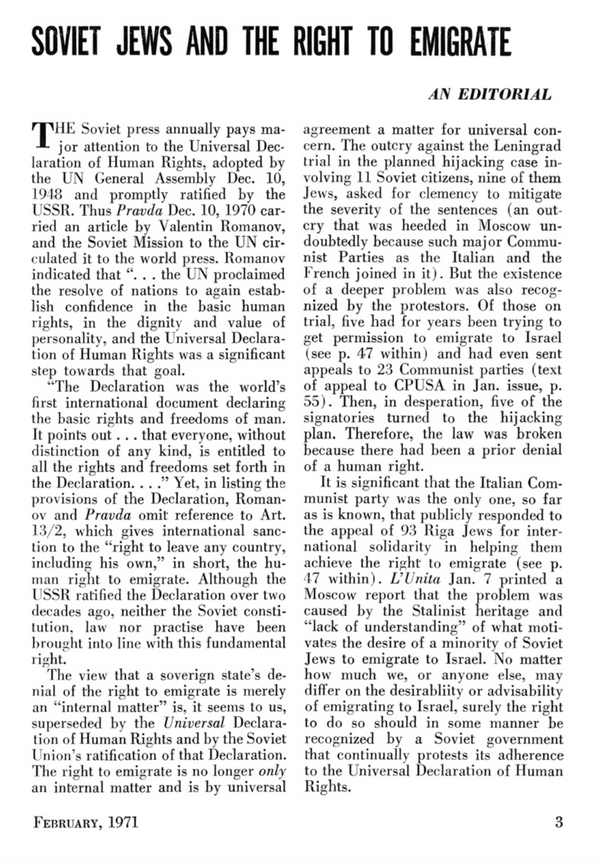
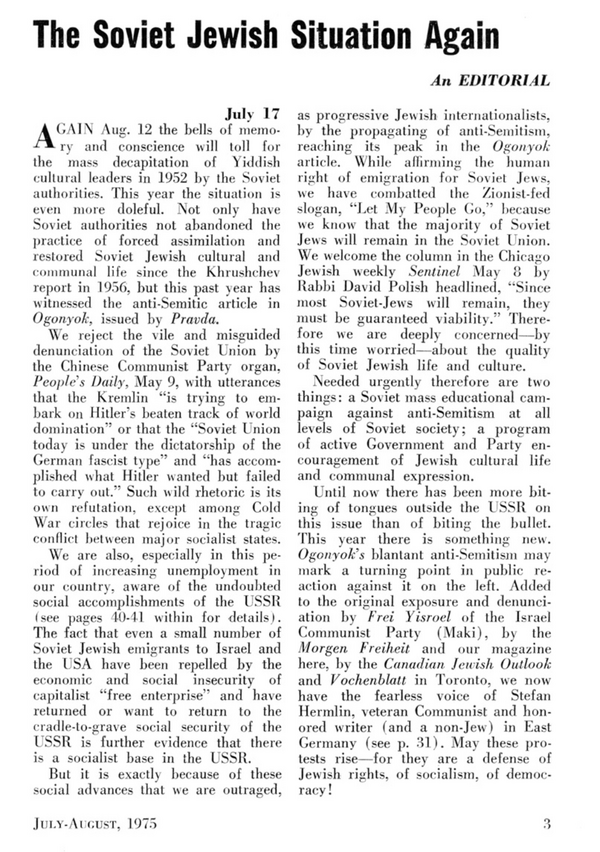
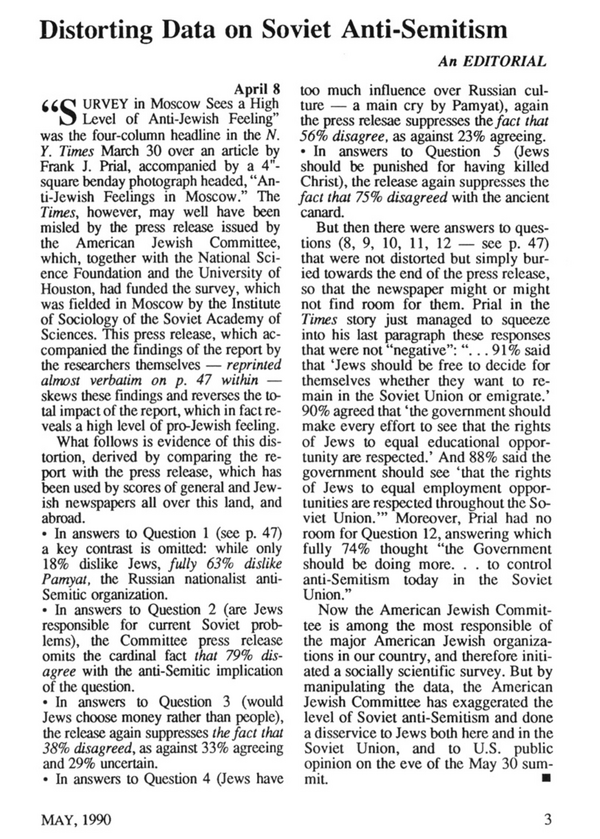
Lawrence Bush edited Jewish Currents from 2003 until 2018. He is the author of Bessie: A Novel of Love and Revolution and Waiting for God: The Spiritual Explorations of a Reluctant Atheist, among other books. His new volume of illustrated Torah commentaries, American Torah Toons 2, is scheduled for publication this year.

